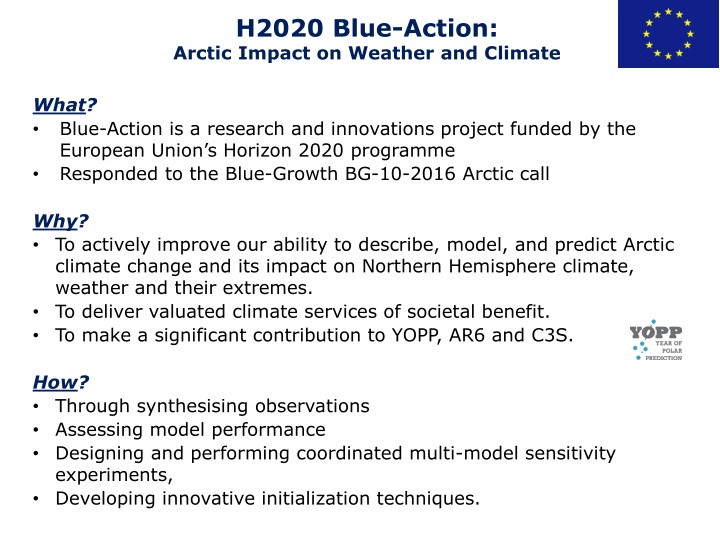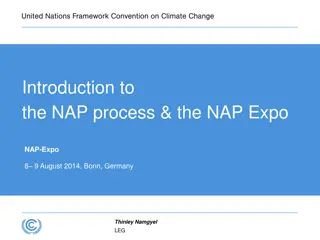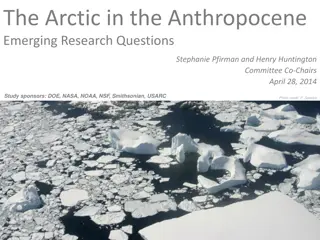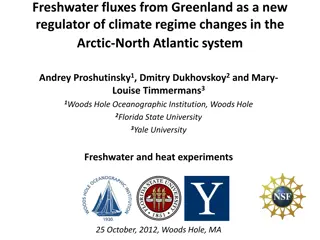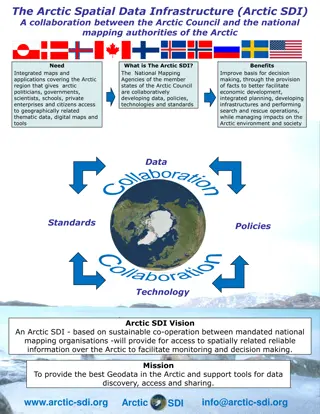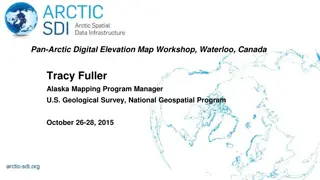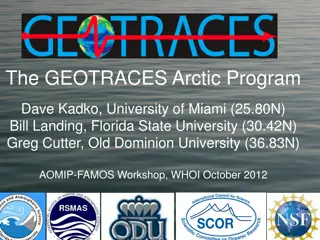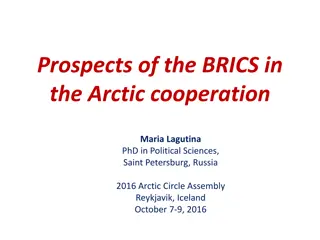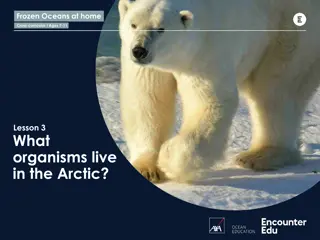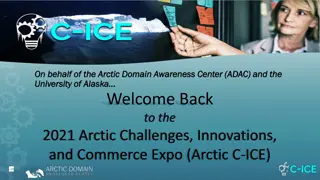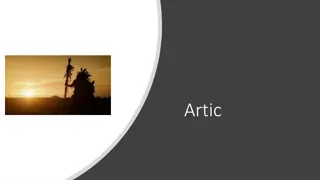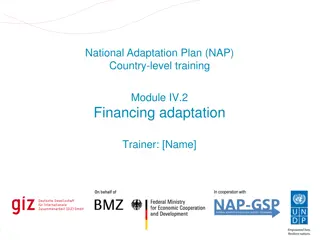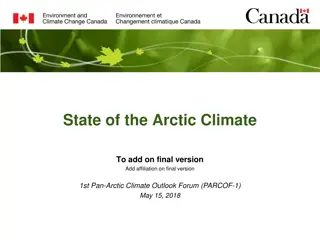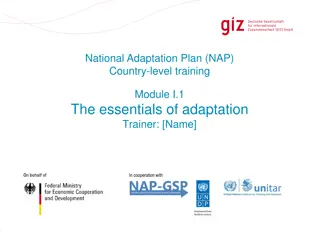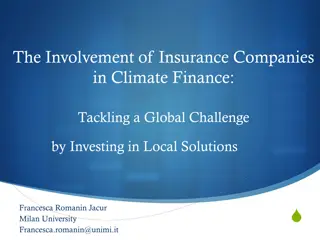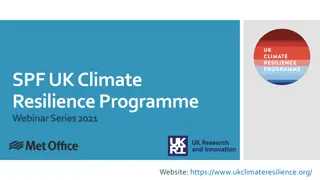Blue-Action Project: Enhancing Arctic Climate Prediction and Adaptation
Blue-Action is a Horizon 2020 project focused on improving our understanding of Arctic climate change and its impact on global weather patterns. By synthesizing observations, assessing model performance, and conducting multi-model experiments, the project aims to provide valuable climate services and contribute to enhanced forecasting capabilities. With experts from 40 organizations across 17 countries, Blue-Action seeks to optimize climate models, improve response to climate change, and enhance stakeholders' ability to adapt. Through innovative techniques and collaboration, the project aims to deliver societal benefits and support economic sustainability.
Download Presentation

Please find below an Image/Link to download the presentation.
The content on the website is provided AS IS for your information and personal use only. It may not be sold, licensed, or shared on other websites without obtaining consent from the author.If you encounter any issues during the download, it is possible that the publisher has removed the file from their server.
You are allowed to download the files provided on this website for personal or commercial use, subject to the condition that they are used lawfully. All files are the property of their respective owners.
The content on the website is provided AS IS for your information and personal use only. It may not be sold, licensed, or shared on other websites without obtaining consent from the author.
E N D
Presentation Transcript
H2020 Blue-Action: Arctic Impact on Weather and Climate What? Blue-Action is a research and innovations project funded by the European Union s Horizon 2020 programme Responded to the Blue-Growth BG-10-2016 Arctic call Why? To actively improve our ability to describe, model, and predict Arctic climate change and its impact on Northern Hemisphere climate, weather and their extremes. To deliver valuated climate services of societal benefit. To make a significant contribution to YOPP, AR6 and C3S. How? Through synthesising observations Assessing model performance Designing and performing coordinated multi-model sensitivity experiments, Developing innovative initialization techniques.
H2020 Blue-Action: Arctic Impact on Weather and Climate Who are we? We bring together experts from 40 organizations in 17 countries on three continents We work directly with local communities, businesses operating in the Arctic and industrial organizations, local authorities and maritime industries. Blue-Action is coordinated by Steffen M. Olsen (DMI) and Daniela Matei (MPI). When? Blue-Action started 1 December 2016 and is a 4-year project (51 months). The Kick-Off is now, in the Harnack-Haus, Berlin 18-20 January 2017!
Overarching Objective - The concept To actively improve our ability to describe, model, and predict Arctic climate change and its impact on Northern Hemisphere climate, weather and their extremes, and to deliver valuated climate services of societal benefit.
The project is expected to: Improve capacity to predict the weather and climate of the Northern Hemisphere, and make it possible to better forecast of extreme weather phenomena; Improve the capacity to respond to the impact of climatic change on the environment and human activities in the Arctic, both in the short and longer term; Improve the capacity of climate models to represent Arctic warming and its impact on regional and global atmospheric and oceanic circulation; Improve the uptake of measurements from satellites by making use of new Earth observation assets; Lead to optimized observation systems for various modelling applications;
The project is expected to: .. continued Contribute to a robust and reliable forecasting framework that can help meteorological and climate services to deliver better predictions, including at sub-seasonal and seasonal time scales; Improve stakeholders capacity to adapt to climate change; Contribute to better servicing the economic sectors that rely on improved forecasting capacity; Contribute to the Year of Polar Prediction (YOPP) and IPCC scientific assessments, and to the Copernicus Climate Change (C3S) services. Improve the professional skills and competences for those working and being trained to work within this subject area. Contribute to implementing the Transatlantic Ocean Research Alliance.
Internal Governance General Assembly is the ultimate decision making body. This will be chaired by the Coordinator and will consist of all partner organizations. Steering Committee will be the supervisory body ensuring successful execution of the project, and will be accountable to the General Assembly. This will be chaired by the Coordinator. Coordinator is responsible for the overall coordination of the project and will act as the point of contact for the European Commission (EC). The Coordinator has ultimate responsibility for ensuring that the project delivers what is expected and oversees the scientific content of the project and ensuring that all work packages are contributing to the outcomes and scientific excellence. Project Office will conduct the routine management of on behalf of the General Assembly. Work Package Leaders and their co-leaders have a responsibility to ensure delivery of their Work Package objectives, deliverables and milestones, working closely with the Coordinator to support the outcomes of the project.
The project office at DMI Steffen Olsen Coordinator Chiara Bearzotti Project manager Katrine Sandvad Financial manager Vivian Henningsen Secretary Collect from Vivian a signed version of the CA!
External advisory boards: Research and Innovation Advisory Group (RIAG) Tasks provide guidance and support regarding the scientific quality and innovation provide high, strategic level guidance, support, and advice on innovation management issues, especially with respect to the scientific relevance and transferability of products and tools help maintain scientific excellence in the program perform yearly internal reviews of progress and results from an independent, external perspective. help promote the project activities beyond the project own scientific community Composition: Darlene Langlois, Guy Brasseur, Mike Steele, Francis Zwiers, Jean-Noel Thepaut (Carlo Buentempo) and Tom Reynolds
External advisory boards: Societal Engagement Group (SEG) Tasks Open up a dialogue between the represented communities and the project, for the project to receive critical feedback on development and results and how these can provide a feed from the communities existing agendas. Providing an additional channel of communication for improve usage of data and information by the communities for enhancing climate adaptation. Composition: Liisa Holmberg (Saami Education Institute), Lene Kielsen Holm (Greenland Institute for Natural Resources), a representative of the Inuit Circumpolar Council (ICC), Jon Burgwald (Greenpeace), a representative of BirdLife International.
WP8: Communication, Dissemination, Engagement and Exploitation Dr Raeanne Miller (WP8 lead) SAMS Research Services Ltd (SRSL) Peter Vangsbo Normann (WP8 co-lead) Climate-KIC Nordic
Enjoy the networking lunch! www.Blue-Action.eu Blue-Action @BG10Blueaction
Clustering for Blue Growth Blue-Action intends to establish a strong clustering activity with the European and international scientific communities focusing on Blue Growth/Arctic impacts and more specifically with: 1) projects funded by the Blue Growth strategy under current and earlier calls; 2) projects funded under other parts of the Horizon 2020 programme relevant for the Blue Growth strategy implementation; 3) Initiatives such as YOPP, PPP, Copernicus, and projects funded by the Belmont Forum/JPI Climate calls. Main outcome will be a series of joint activities for allowing the exchange of data and results between the scientific communities beyond the project.
Clustering EU-PolarNet Connecting science with society AtlantOS Optimising and Enhancing the Integrated Atlantic Ocean Observing Systems AORAC-SA Atlantic Ocean Research Alliance CERES Climate change and European Aquatic Resources Projects under the work programme 2016-2017 especially INTAROS (BG9, Stein Sandven) Integrated Arctic Observing System APPLICATE (BG10) Advanced Prediction in Polar regions and beyond
Clustering Joint workshops ( Mapping the gaps events) What are the optimal methods to initialize ocean heat content, snow cover and sea ice to and to represent the initial uncertainty in prediction systems? How is sub-seasonal to seasonal predictive skill modulated by decadal climate variability? Are predictive systems and the observational network adequate to fully exploit the predictive potential related to arctic freshwater storage and release through ocean linkages? How can long-term predictions be used in innovative fisheries and ecosystem services? How will improved representation of small-scale processes of particular relevance for the Arctic affect the two-way linkages between the Polar Regions and lower latitudes?
